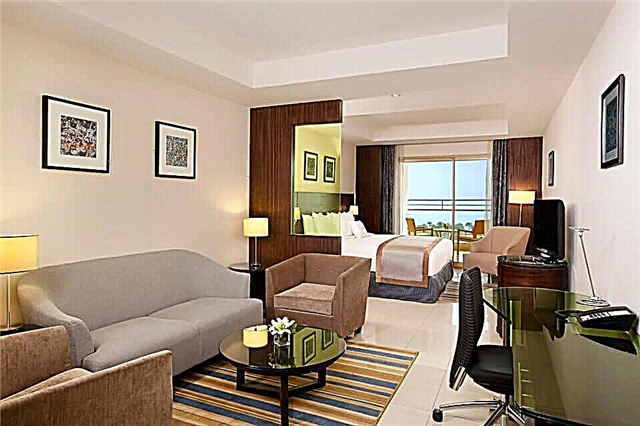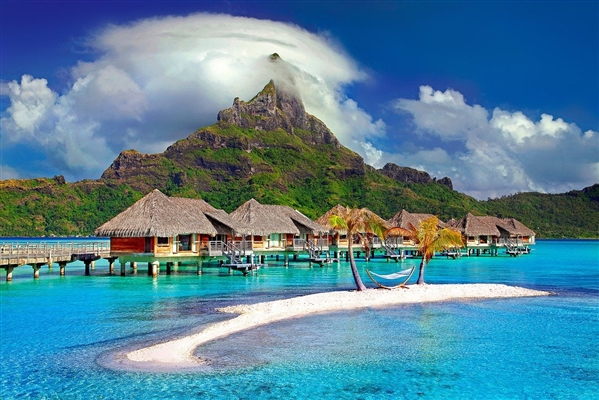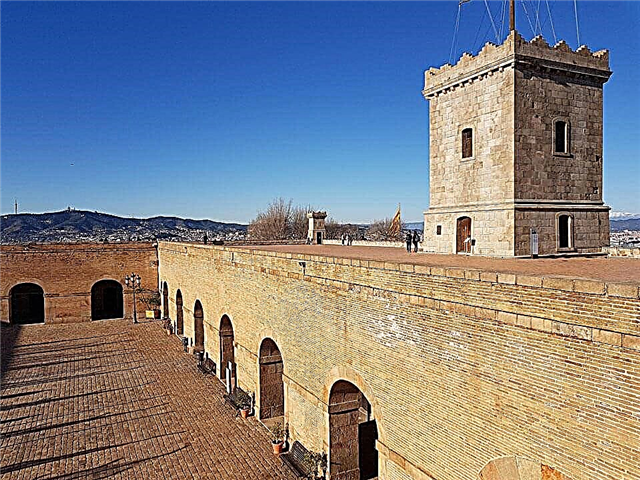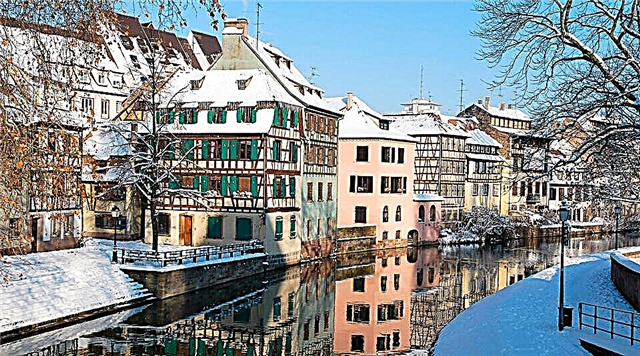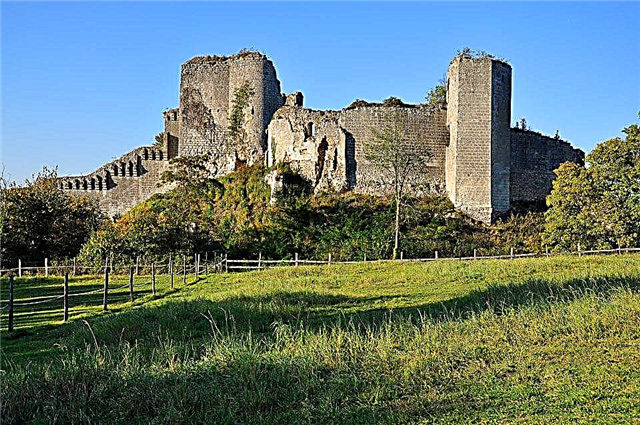The Loire castles are an integral part of the valley, listed as a natural heritage by UNESCO. How did it happen that about 50 fortresses were grouped in a small square? The answer is simple: this area in the IX-XII centuries served as a border with the warlike Normans, so the feudal lords sought to protect their possessions by building forts. For the fortresses they chose a steep river bank, a rocky cliff. The river provided natural protection, and from a height the valley could be seen far away. The buildings were unprepossessing: their main purpose was the shelter of the garrison and the knight with his family. But in the 15th century, the situation changed dramatically. Italian campaigns showed the French nobles that life in the fortress can be not only safe, but also quite comfortable. Feudal lords began to rebuild estates: instead of plain houses, palaces were erected, and gardens and parks were laid out around. New chateau were built already in the valley, harmoniously fitting into the landscape.
Chambord

Built at the whim of Francis 1. The king chose the place, in his opinion, the most suitable for habitation: huge forest lands, endless fields. But the territory that attracted the monarch turned out to be swampy, so it first had to be drained. But even after the completion of the work, oak piles were used as a foundation: otherwise there would be water in the rooms. Chambord was a medieval long-term construction: it was erected for 28 years. By the way, Francis 1 did not wait for the execution of his order.
Chambord belonged to the royal family: it was inhabited by the heirs of Francis. Then the building was abandoned for a while. But then they began to provide various people who arrived in France: Stanislav Leshchinsky, Saint-Germain, there was also a field hospital here. In the 30s of the twentieth century, it became state property, it was opened for tourists. Here you can watch a beautiful music and light show. And it is allowed to visit the forest as part of an excursion group in September-October.
Unfortunately, out of 500 rooms, only a few have been reconstructed. They recreate the atmosphere of the Middle Ages. The main attraction is the double spiral staircase. Presumably, it was designed by Leonardo da Vinci. In general, there are more than 70 tangled stairs: researchers believe that this is how Francis 1 tried to avoid conflicts between the favorites, whom he received at the same time.
Villandry

The palace has a difficult history: the owners changed, the appearance of the building changed:
- It was originally a well fortified fort that could not be captured from the 13th to the 16th century. But the construction was rough and the interiors were ideally suited to the needs of the garrison. It was within its inhospitable walls that the Azay-le-Rideau treaty was signed.
- In the middle of the 16th century, Villandry received the possession of Breton, Secretary of State Francis 1. He supervised the construction of Chambord and Fontainebleau, therefore he also wished to stop his personal residence in an exquisite place. All unpresentable buildings (except for the central tower) were demolished, a new building was erected in the shape of a horseshoe. And the courtyard was decorated with arched galleries. At the request of Breton, the stone walls were replaced by hedges, and the park began to harmoniously complement the structure.
- In the middle of the 18th century, Villandry became the property of the Marquis of Castelana. He believes that the palace needs to be radically changed. Villandry received new premises (galleries, balconies), window openings decreased. This is how the building lived for 2 centuries.
- But in the twentieth century, Dr. Carvallio addressed the public with a call to return Villandry to its historical appearance. The idea was supported: the shape of the windows was changed again, the galleries were rebuilt. But historians argue that the reconstruction did not affect a significant part of the park and the southern façade.
The interiors are striking in chic and sophistication: the atmosphere of the 18th century is authentically recreated here. And some of the interior items are genuine. You can get inside with a guided tour, and the tower offers an amazing view, which is included in the UNESCO natural heritage list.
Amboise

Initially, it performed a defensive function: it was an impregnable fortress, towering 40 meters above the Loire. Such a fortification could withstand a long siege. In the 13th century, the fortress began to belong to the Amboise family, and later to the crown. The fortress was completely reconstructed with the coming to power of Charles 8. He loved luxury, so he decided to completely rebuild the estate. It was Charles 8 who came up with the idea to create the famous Italian gardens on the territory of the fortification.
Francis 1 spent his childhood in Amboise. Subsequently, the monarch devoted much time to the palace, and for technical solutions he invited Leonardo da Vinci. Subsequently, the royal family left Amboise, the palace was abandoned. And during the French Revolution, there was a factory for making buttons. It was during this period that Amboise almost died: a member of parliament proposed dismantling part of the fortress, selling the stones to cover the costs of maintaining the bulky structure.
The interiors perfectly convey the atmosphere of the Middle Ages. Here is a collection of furniture from that period. And the rooms are named after famous women who lived in his chambers at different times. Tourists willingly visit the exhibition dedicated to Leonardo da Vinci.
Blois

Blois history begins in the 9th century. It was then that the first citadel was built on a cliff above the Loire. It was absolutely not a preliminary structure: on the one side there was a high cliff, on the other - a deep river. But large-scale construction began in the time of Louis Orleans. Subsequently, Charles of Orleans, who had returned from English captivity, the patron saint of artists and poets, lived in Blois. The king of France, Louis XII, was also born in the castle.
Louis XII made the capital of the city of his birth and took up the arrangement of his personal residence. At this time, there was no longer a need for well-fortified fortresses, so the monarch directed all his forces and means to build a new wing. The case was naturally named after its creator. This building differs significantly from the rest of Blois buildings: luxury and sophistication reign here. By the way, having received the Archduke of Austria in the new residence, the far-sighted Louis XII prevented a military conflict with Austria. The monarch of a neighboring power was subdued by the courtesy and blinded by the wealth of Blois.
The palace was also loved by Francis I. He built his own wing, on the facade of which he immortalized the motto: I encourage good, but I also hate evil soul. In order for the descendants to remember the lesson well, it was recorded 12 times.
Unfortunately, after Francis I left Blois, the residence was abandoned, it began to decay. For some time, the disgraced Gaston of Orleans lived here, who began the construction of his own wing. The construction of the building stopped pretty soon.
Blois miraculously survived during the reign of Louis XVI: the king wished to sell the residence, and if there was no buyer, then to destroy the fortress. Fortunately, the vassals dissuaded the king from barbarism: the monarch ordered the deployment of a garnion in Blois.
The French Revolution completed the decline of the fortress. Only in the 18th century did the first reconstruction begin, which was harshly condemned by architects for adding non-existent elements. Today Blois has been restored to its original form: it is an amazing monument that combines the features of several historical eras.
Chenonceau

This castle is one of the few privately owned in France. But the owners willingly let tourists into the building and into the surrounding area. Historians call Chenonceau a women's castle. And there is a logical explanation for this, famous women of different eras took an active part in the arrangement:
- The wife of the owner of the castle, Ekaterina Boye, rebuilt the fortress on behalf of her husband, leaving only the central tower and the rising bridge. And she also laid out a huge park around the new house.
- After the death of the Boye couple, Francis 1, who knew a lot about beauty, takes the estate from the heirs, declaring the latter to be traitors. And his heir, Henry II, donated the royal residence to his favorite, Diane de Poitiers. The lady had an exquisite taste: she took up the rebuilding of the garden, planted exotic plants. Diana built a stone bridge across the Cher River.
- Left a widow, Catherine de Medici considered it her duty to take the castle from her rival. The Queen Mother did little landscape design, but she transformed the park purely intuitively: an amazingly beautiful gallery appears on the bridge. In addition, Catherine creates a second park that should overshadow the gardens of Diane de Poitiers.
- Subsequently, his wife lived in Chenonceau with King Henry III. Rumor called her the white queen, because the widows' mourning robe is white.
- After the death of the white queen, Chenonceau gradually fell into decay. The sad fate was changed by the purchase of a residence for his wife by Dupin. Madame Dupin turned the dull building into a salon, which Jean-Jacques Rousseau eagerly visited. It is noteworthy that Madame Dupin was merciful to the servants, therefore, during the French Revolution, Chenonceau was not plundered and destroyed. It was not even confiscated.
- But the main merit in creating the look that Chenonceau has now belongs to Madame Pelouse. But this lady was mistress for a short time: the estate was taken away to the treasury for debts.
The last owners are the Meunier family. Meunier's descendants participated in the Resistance, and partisan meetings were held in the castle. This family still owns Chenonceau.
Buteon

The first owners, the Count du Forez family, were concerned about the security of their possessions, so they built an excellent fortification on the banks of the Loire. The construction was rough, but it served the purpose perfectly. In the 14th century, the building changed owners: first it was Fey, then - Shalyu. In the 15th century, Duke Jean of Bourbon buys the estate to present to his mistress. During this period, the reconstruction of Buteon begins, in accordance with the ladies' needs.
Duke Jean's son inherits the palace after his mother's death. He continues to equip the fortress, builds the northern wing. But Mathieu de Bourbon had no children, so after his death his cousin Suzanne de Bourbon became the owner. In the 18th century, the next owner of Buteon, Claude Antoine, was killed during the siege of Lyon. The estate was fragmented: the fortress itself passed to the Baron of Monttime, and the land and forests were sold out in parts.
In the 19th century, Buteon acquired a wealthy philanthropist and donated the estate to his wife. Another reconstruction takes place: new parts are added and old parts are returned. During World War II, the French fleeing from the Lorraine region hid in Buteon. In 1995 the municipality bought the palace. Buteon is being reconstructed again, this time trying to return to its original appearance. Now it is a tourist destination. In addition, Buteon hosts themed exhibitions and music events.
La Roche

The first owners chose, as it seemed to them, a convenient place to control the Loire Valley. The rocky island was inaccessible from land, the towers of La Roche provided an excellent view of the borders of the county. But the flip side of this situation was that La Roche was constantly destroyed by large (and not so) floods. The owners spent huge sums of money to put the building in order.
In the end, in the 17th century, another blow of the elements damaged the palace so much that the owners refused to restore it. For a long time, La Roche stood abandoned: little remained of the Gothic façade. Rather, it was just a neglected, unkempt mansion.
At the beginning of the 20th century, a native of Rouen buys a dull building and begins to remodel it. But the project for the creation of a reservoir (1930) presupposes the complete flooding of the medieval chateau. The community of the county intervened in the matter, the project was changed. But the threat of flooding still remained.
Today it is a picturesque place where there are many tourists from spring to late autumn. Music evenings, costume balls, games for children and adults are held here. The halls display medieval costumes, culinary and craft master classes.
Palace of the Dukes of Nevers

The building was erected at the end of the 15th century. The customer was Count Jean de Clamensi. But already in the middle of the 16th century, the new owner (François I of Cleves) made changes to the original project. Then the subsequent owner (Count Gonzago) changed the appearance of the building:
- appeared caryatids
- pilasters added
- cut through the windows in the attic of the 3rd floor
- the windows in the central tower were decorated with bas-reliefs
- the interiors were decorated with new fireplaces
But the northern part of the palace has retained its original Gothic features. The most elegant space was the courtroom, which was personally designed by Cardinal Mazarin. Today, state institutions operate in the palace, there is a salon and a hall where marriages are registered. In the rest of the rooms, the interiors of the Middle Ages are recreated, you can see them.
La Bussière

Unlike most castles in the Loire, La Bussien is privately owned. The Fisherman's Castle was built in the 12th century as a fortification, but later converted into a pleasant and picturesque residence. Descendants of the Chaseval family, the Chaisval couple, opened the reconstructed palace for tourists in 1962.
Guests are offered:
- medieval halls with reconstructed furnishings
- basement with instruments of torture (there the knights pacified the rebellious)
- maze
- boats, nets and tools for freshwater fishing
- a vegetable garden that produces vegetables eaten in 18th century France
- lush gardens where juicy fruits ripen
- kitchen with utensils of the Middle Ages
And all this is linked to the art of freshwater fishing. The Chaisval family project is so successful that La Bussière has been included in the UNESCO list of sites.
Gien

The residence belonged to the Gien family from the time of construction until the French Revolution. The original purpose is to protect the possessions from the barbarians.
The fortress has a rich history:
- Charles VII lived here for a short time, after the Virgin of Orleans liberated the city
- the residence was presented as a gift to his bride (daughter of Louis XI Anne) by one of the Counts Gien
- Henry II and Catherine de Medici stayed here
- in Gien, the Sun King and Anna of Austria were hiding from the Fronde
After the French Revolution, Gien became municipal. It housed the prefecture, court, and prison. In the 18th century, the building acquired a new wing. During the Second World War, Gien was partially destroyed. In 2012, the French government allocated funds for the reconstruction of the palace. The building has acquired its original appearance, and archaeological research has been carried out on the territory. Since 1952, the International Hunting Museum has been located within the walls. It occupies all the premises, an extensive exposition consists of more than 15,000 items.
Sully-sur-Loire

This fortress was built in the 12th century by the Sully family in order to control the bridge over the Loire. But in the 15th century, the crossing was destroyed, and the fort remained. And the owners gradually adapted it for their own residence:
- in the 16th century, Sully-sur-Loire receives a new wing
- in the 17th century, the building is completely rebuilt (in accordance with the time, the building acquires the features of the Renaissance architecture)
- in the 18th century, the ensemble gets its logical conclusion: old and new buildings are united by a building oriented from north to south
The impregnable Sully-sur-Loire protected those in danger: in the 17th century, the young Sun King was hiding here from the Fronde, and in the 18th - Voltaire. Sully-sur-Loire almost died several times: it was badly burned out at the beginning of the 20th century, and during the Second World War its buildings were partially destroyed by German shells.The dukes of Sully owned the fortress until 1962, then the building was acquired by the Loire department. Sully-sur-Loire has been reconstructed and turned into a tourist attraction.
The center hosts the annual International Classical Music Festival. In addition, in the chambers there is an exposition dedicated to the life of the feudal lords. The architectural ensemble is also interesting: the two complexes are located in different territories, which are surrounded by a common canal. This moat is part of a system that protects buildings from possible flooding. On the territory there are gardens that were designed by the Duke of Bethune.
Meun-sur-Loire

Unusually, this fortress was built in the 12th century at the direction of the Bishop of Orleans. And the goal was the same: to protect the land holdings of the Church of St. Lifar and the adjacent monastery from enemies. Initially, the fortress had 2 observation towers with loopholes, crowning the unpresentable structure of a square profile. But subsequent bishops paid due attention to the building: it expanded, towers, a guardhouse, cellars and a drawbridge were added. True, after a while, instead of the bridge, an entrance tower was built.
Meun-sur-Loire was the official residence of the Orleans bishops, so Francis 1, Charles VII, Louis XI were received here. The fortress was in a good location: its small garrison completely controlled the river valley. Therefore, during the Hundred Years War, Meun-sur-Loire was captured by the British, who made the fortress completely inaccessible.
After the Maid of Orleans recaptures Meun-sur-Loire from the British, a prison is set up in the fortress. Here prisoners awaited the trial of the bishops or the king. The most famous "guest" of the fortress was the poet and criminal Francois Villon. Before the French Revolution, Meun-sur-Loire was ruled by the Bishops of Orleans. Then the palace was bought by a banker. The complex still belongs to him today, but it is open to visitors. Currently, restoration is underway, access is allowed to 30 out of 131 rooms.
Cheverny

There are many unusual moments in Cheverny's story:
- The fortress from the moment of its construction to the present time belongs to one Guro family. A period of less than a year in which the property was owned by outsiders can be excluded.
- Henry II confiscated Cheverny from Guraud, accusing the vassal of high treason. And the fortress was presented to Diane de Poitiers. The lady was offended because she considered the ugly building unworthy of her person. A few months later, she sold the estate to the Guraud family. Isn't it a wonderful return!
- The French Revolution and subsequent wars did not cause significant damage to the property. Therefore, it was possible to preserve the original interiors and furnishings of the mansion.
- Cheverny opened its doors to guests in 1922. Despite being privately owned, it became the first tourist attraction among the castles of the Loire.
The first owner of the fortification, Jacques Guraud, decided to defend himself and his possessions. For this, he built a fortress on the site where an ordinary mill stood. The mill turned into a walled building bristling with loopholes. For complete safety, a deep ditch was dug around and filled with water. Such a fortification made it possible to repel a sudden attack, and, if necessary, survive a long siege. But no one began to attack Guro, and soon the descendants of the valiant knight began to rebuild the unsightly dwelling.
All the original buildings were demolished: utility rooms were erected instead of walls and towers. Local limestone was used for the central buildings. It has a peculiarity: it becomes lighter over time. Therefore, today tourists call Cheverny a dazzling palace. Despite the availability of free finances, the business progressed slowly: Heinrich and Margarita Guraud died of old age, without waiting for the end of construction. But it was designed by Cheverny Bougier, who created Chambord and Blois.
Today tourists can see the armory, the canteen, the trophy room, and the living rooms. Of particular interest is the "dog soup" attraction. There is a kennel in Sheverly, where more than 60 pedigree animals live. A large number of tourists flock daily to feed them.
Beauregard

The original fortification was erected in the 15th century by Count Dulce. Subsequently, the uncle of Francis I owned the fortress, but he did not make a significant contribution to the transformation of the chateau. The reconstruction of the fortress was undertaken by Jean de Thiers, who bought it in 1545. De Thiers erected new premises, skillfully combining them with the existing ones. Unfortunately, the name of the architect who embodied de Thierry's plan is unknown. The interiors were created by court painters and sculptors: the financier of Henry II could afford such a luxury.
On the south side, the estate was decorated with a garden where exotic plants bloomed and bore fruit. The area of the park is 70 hectares. Today, you can see the remains of a chapel from the 15th century. The next owner of the chateau, Paul Ardier, began a general reconstruction of the building: he added symmetrical buildings to replace the old buildings. He also founded a portrait gallery. All paintings are copies from canvases of famous artists depicting statesmen of France.
In 1864, Prosper Mérimée made an appeal to recognize Beauregard as a cultural heritage site in France. Today, the owner of the chateau is du Pavillon. Beauregard is proud of the red room. All details in it are made of mahogany. Tourists willingly visit the portrait gallery, which displays portraits of more than 300 kings and statesmen of France.
Chaumont-sur-Loire

The first wooden fortress was built by the Comte de Blois to protect the lands from the raids of the aggressive neighbor of the Count of Anjou. Soon the château is bought by Count d'Amboise: his family has owned the estate for almost 5 centuries. Louis XI accused d'Amboise of treason, so he ordered the destruction of the family residence. But every cloud has a silver lining: the surname d'Amboise is rebuilding the chateau again, but already in stone. The construction began with the west wing: it looks like the most impregnable. The restoration of the fortress was carried out by 3 generations of d'Amboise, so the austere style acquired some elegance.
In the 16th century, Chaumont-sur-Loire changed its owner again: it became the property of Catherine de Medici. The queen lived for a long time in the chateau, here she invited astrologers: an observatory was even organized for them in the tower. A collection of Catherine's tapestries has been preserved, of which the queen was a connoisseur and lover.
After the death of Henry II, Catherine de Medici decided to take revenge on Diane de Poitiers: she forced the former favorite to exchange Chenonceau for Chaumont-sur-Loire. Diana spent the years remaining before her death in the new residence. Her bedroom has survived, which is easily recognizable by its coat of arms and monogram.
The situation changes when the d'Aramont family buys the residence. The Count hires the architect Morandier to restore the building. And after 100 years, Chaumont-sur-Loire becomes a state. It is being restored again and turned into a tourist center. Every year the International Festival of Gardening Art is held here.
Montjoffroy

This chateau has completely recreated interiors from the 18th century. Fate was favorable to Montjoffroy:
- the estate belongs to the same family, de Contada
- the building survived the robberies of the French revolution
- modern owners decided to keep the interiors that were under the first owner
The chateau was erected by the Marquis de Contad of France at the end of the 18th century. Local sandstone was used for construction, which has an interesting property: it becomes lighter over the years. The building is in the shape of a horseshoe, the style of construction is defined as the Renaissance.
The marshal was not constrained in funds: the furnishings were ordered from the best craftsmen. But he was also kind to the peasants. Such kindness returned a hundredfold: the commoners saved Montjoffroy from plunder during the revolution. It was even left in the hands of the owners.
During World War II, Montjoffroy was not affected by shelling or bombing. The only thing that the chateau could not resist was time.When, at the end of the 20th century, the owners decided to restore the building, they were faced with the fact that the interiors were completely destroyed.
The situation was saved by the documentation, which was kept perfectly by the previous owners: invoices from suppliers of fabrics and furniture were found. Some companies are still operating. Restorers ordered upholstery from the surviving samples. At the same time, they were guided by the principle: the same fabric should be on furniture, curtains and walls. The owners did not re-plan Montjoffroy, so tourists can see the reconstructed interiors in the premises of the 18th century.
Castle of the Dukes of Brittany

This fortress was built in the XIII century by the Duke of Breton Guy de Toiret to defend against the warlike Normans. At the same time, he took part of the estate of Bishop Geoffroy. The case was considered in the royal court, while the usual red tape dragged on, Guy de Toiret dug a rectangular ditch and laid the foundation of the tower.
The first fortress consisted of a single tower surrounded by a wall. As soon as the premises were ready for living, the duke's family moved to a new residence. Then the descendants of Guy de Toiret completed the fortress according to their own taste: towers were added, inscribed in the fortress wall, a drawbridge, and a large palace was built. At the same time, not only comfort was taken into account, but also the defensive value of the structure: the Duchy of Breton remained isolated.
Not only the men who owned the chateau took care of its strengthening: Anne of Breton and her daughter Clotilde, becoming queens of France, did much to make the family residence prosperous. In the middle of the 16th century, the fortress became a royal residence for some time. This influenced the fate of the chateau during the French Revolution: the rebels offered the city to ransom the plundered palace. But the municipality did not have such a sum, so the people turned the fortress into a prison for the nobility and royalists.
In 1800, a gunpowder warehouse exploded in the fortress: the buildings were destroyed or damaged. Restoration work was carried out, and then the city bought out the residence. An exhibition of arts and crafts was opened in the restored premises. The Second World War spared the fortress. But it was abandoned for a long time, so the buildings were dilapidated. Reconstruction began only at the end of the 20th century. Today, guests are offered permanent and thematic exhibitions. You can just walk around the territory, go around the fortress along the top of the wall.
Chateauden

The first tower of the fortress was built in the XII century by Count de Blois Thibault V. The goal is usual: to protect the possessions from the attack of the Normans. Chateaudun is the strongest fortification on the Loire River. Donjon is a residential building and at the same time a fortification. Next to it there is a chapel, protected by a fortress wall.
Much was done for the construction of Chateaudun by its most famous owner: Bastard Jean de Dunois, associate of Jeanne the Virgin. The illegitimate son of the count was brought up together with the future king of France, Charles VII. He was instructed to ransom Charles of Orleans from English captivity. For the successful completion of the assignment, Bastard received Chateauden. By his order, the western wing was erected.
At the end of the 15th century, François Orleans-Longueville built the northern wing of the fortress. The style of construction combines the traditions of the Renaissance and the Gothic canons. During the French Revolution, Chateaudun was plundered by rebels, and later the fortress turned into a barracks. Since 1938, the fortress has been owned by the state. Today Chateaudun is open to tourists. Guests are invited to see the interiors of the 18th century, an exposition of ceramics, frescoes of the chapel. The jewel of Shitoden is the Alencon County Tapestry Collection.
Montoir

Chateau de Montoire was built in the 11th century by the Montoire family. The fortress's favorable geopolitical position led to an ongoing struggle for the estate between the Montoire and Lavardin families. In the XII-XIV centuries, the fortress was rebuilt. Now the fortress belongs to the commune of Montoire-sur-le-Loire, but picturesque ruins remain from it. Chateau de Montoire is a cultural monument, tourists can view it absolutely freely.
People

The first owners of Luda were the Dukes of Anjou. They built a fortress of wood to oppose the Norman warriors. But soon the building was replaced with a stone one. But one day the fortress surrendered to the British. Marshal Gilles de Retz returned it to France, to whom the king gave it to Lud. True, soon the disgraced military chateau was confiscated.
At the end of the 15th century, Lud buys Jean de Dion. He was wealthy enough to rebuild the fortress to his liking. And most of all, Jean loved fun and entertainment. During this period, which lasted almost 100 years, the count and his descendants decorated the fort, turning it into a real palace. And around they laid out a garden and a park, where strange flowers smelled and exotic plants grew.
In the 18th century, Lud began to belong to the Vieville family. The owners of the East India Company had sufficient funds to make the residence luxurious. A bas-relief was erected on the site of the moat, and a garden was laid out around the palace. During the French Revolution, the Luda garrison could not resist the rebels, the fortress was captured, plundered and destroyed. But in the middle of the 19th century, the chateau returned to the Vieville family. Reconstruction was started. Now the estate welcomes tourists, holds gardening art festivals.
Angers

The first fortification was built in the 9th century on the high bank of the River Men by the Duke of Anjou Fulk 3. Standard purpose: protection from aggressive Normans. And an impregnable fortification on this place was erected by Saint Louis IX. Walls 50m high unite 17 towers. Few dared to storm such a fort.
But behind the impregnable walls were hidden graceful palaces, where the dukes of Anjou led a luxurious life. Knight tournaments were regularly held here, animals were kept in the menagerie, the territory was decorated with a park. A vegetable garden was set up near the palace, where vegetables for the duke's table were grown, beds for medicinal and spicy-aromatic plants were dug up.
In the 16th century, by order of Henry II, they tried to destroy Angers. But they only managed to reduce the height of all 17 towers. By the way, such a change was beneficial: after the towers were connected by a gallery with cannons, the fort became absolutely impregnable. The fortress stood on the high bank of the Men River, and from the remaining sides it was protected by an artificially dug canal, so it was impossible to get close to the walls by land. You could only enter or enter through the drawbridge.
Today Angers is open to tourists. At the bottom of the drained ditch, the reconstruction of the camp of the medieval knights is arranged. You can inspect tents, touch weapons, climb the wall and see the surroundings of the city. The territory is well-groomed: a garden, a pharmaceutical garden, a vineyard are laid out. There are expositions in the palace.
Ene-le-Vieuil

Ene-le-Vieuil is a private property that has the status of a private historical monument. In addition, the surrounding park has received the status of a Wonderful Garden, which is awarded by the French government to the best ensembles. The fort performed important defensive functions: it blocked the way for the troops of the Dukes of Aquitaine, who held the hand of England. Ene-le-Vieuil was built on a plain, so it had 2 lines of fortifications. Currently, the outer borders have been destroyed.
During the Hundred Years War, the fortress was never taken by attack, the garrison withstood assaults and long sieges. Today, some of the premises are used for permanent residence of the owners. The rest have original interiors and are available for tourists. In the royal hall, everything remained unchanged from the moment the royal couple visited the palace. Only monos L and A (Louis and Anna) were added, the emblems of the royal spouses: lilies and ermines.
Valence

The first building on the site of modern Valance appeared in the 10-11th century. It was an unsightly lonely tower. In the 13th century, Sir Gauthier de Valance built a small fortress around it.But as a dowry, Valance began to belong to the Chalon-Tonners, who completed the buildings inside the fortress. At this time, the Hall of the Guards was built, connected to the fortress walls by an underground passage.
In the 15th century, the d'Etamp family rebuilt the estate: a gallery was erected, and work began on the palace. The architecture shows the characteristic features of the Chateau Chambord. By the early 19th century, Valence was a rich and luxurious estate. Its last owner sold the estate to Talleyrand. The Napoleonic minister did not have enough money, so some of the amount was contributed by Bonaparte himself. It was Talleyrand who made Valence what tourists see it today.
It is noteworthy that the princes of Spain were serving an honorary arrest at the estate. To entertain the captives, Napoleon suggested that Talleyrand organize a theater. In 1810, the actors gave their first performance. For a quarter of a century, all the noble persons of Europe sought an invitation to the luxurious Valence. After Talleyrand's death, the chateau was inherited by his distant relative, who received the title of Duke de Valence. And since 1980, the estate has been owned by the state. The department monitors the condition of the complex, carries out restoration work.
Champigny

The fortress was built in the 12th century by the knight Bouquet. Subsequently, it began to belong to the Dukes of Orleans. In the 17th century, the estate was acquired by Cardinal Richelieu under a barter agreement. The new owner began to destroy all existing buildings, leaving only the Jupiter Pavilion intact. Richelieu planned to destroy the chapel, but the Pope prevented the barbarism. After 3 decades, the Duchess of Orleans won the court and received the destroyed estate and monetary compensation, which she used to organize the park.
The twentieth century, unfortunately, brought new disappointments: Champigny was bought by a company from Japan. Mediocre management led to the fact that some of the architectural elements and interiors were lost. The 21st century turned out to be more successful for Champigny: it was acquired by a family of Americans who have already restored part of the premises and placed an exposition in the halls. Restoration work continues, but tourists are encouraged to view the reconstructed part of the building and the exhibition.
Montreuil-Bellay

The fortress was founded by Fulk III of Anjou in the 11th century, and soon handed it over to his subject, du Bellay. Since then, the château has been named after the knight: Montreuil-Bellay. The fortress had an underground passage that made it possible to communicate with La Mot-Bourbon. Unfortunately, the galleries have been destroyed. In the 14th century, the owners turned the chateau into an impregnable citadel, and in the 15th century, it was rebuilt in accordance with the traditions of the Renaissance. It was during this period that the Chateau-Neuf (new castle) was built, the old ones were altered and new premises were added.
During the wars of religion, Montreuil-Bellay was besieged, but repelled all attacks. Moreover, the owners of the fortress gave food to both warring parties. During the French Revolution, female royalist prisoners were held here, and during the Second World War, a hospital was deployed. Since 1979, Montreuil-Bellay is a cultural monument of France. An exposition is open here, the pearl of which is the Crucifixion fresco. Its author is a student of da Vinci.

